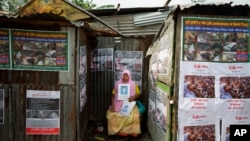This week marks 10 years since the Rana Plaza collapse, the Bangladesh garment industry’s worst tragedy that killed 1,134 workers inside an eight-story Dhaka factory. But the legal battle over the deadly building collapse has made little headway.
The factory collapsed just before 9 a.m. on April 24, a day after workers raised concerns about cracks appearing in the walls. In the hours and days following the collapse, this correspondent witnessed the frantic rescue calls made by the people trapped inside. As rescue workers struggled to reach them for days afterward, many slowly perished.
Of the 14 legal cases filed over the disaster, 13 have seen little progress over the past decade. Only 45 witnesses out of 594 have testified in court in the last 10 years. Who is responsible for the slow pace is in dispute.
10 years of testimony
Bangladesh courts sentenced Rana Plaza building owner Sohel Rana and his mother, Morzina Begum, to prison for corruption charges in 2017 and 2018. The owners, along with some 40 other people, still face charges over the collapse. Thirty-eight people are accused of murder. Trials have been stalled for years at a time as the accused persons went to the High Court to secure stay orders.
Prosecutors blame delays on the stay orders and the logistical difficulties of transporting victims of the disaster to court. Public Prosecutor Bimal Samadder told VOA, “The trial proceedings were halted for eight years only due to stay orders of some accused persons.” He said there was still no indication of when the trial would conclude.
“The biggest challenge here is that the witnesses are very needy. Many had moved to their village home after the incident. We bring them to Dhaka with the help of the police and bear the cost of their travel from our own pocket,” Samadder told VOA.
A survey done by the Institute of Social Business on behalf of ActionAid Bangladesh found that 55% of the survivors of the disaster were still jobless and 89% of them did not have any work for five to eight years.
Senior journalist Masudur Rahman has been following the cases closely for 10 years and told VOA the process of taking testimony was laborious. “The witnesses are spread across different districts of the country," he said. "Some of them are injured; some are mutilated, while some are mentally ill. Many had moved to their villages after the incident.”
He said that even when witnesses do appear in court, there sometimes are too many other cases that prevent them from testifying.
“A total of 15 witnesses were scheduled to testify [at] the latest date, but deposition of only eight of them was recorded. They go back dejected when they come here but can’t testify.”
Labor leaders and rights activists contend that ultimately it is the government that bears responsibility.
Taslima Akhter, president of Bangladesh Garment Sramik Samhati, a labor rights group, said the fact that no one who designed the building or who approved the construction had been held accountable was part of the reason the situation remained “utterly tragic.”
“We think the government’s negligence and carelessness are partly to blame," she said. "Such delay in the trial process proves again that the government and owners don’t consider the workers even as humans.
Despite criticism of the handling of the trial, Akhter said there were signs the work environment in factories had improved somewhat since the Rana Plaza collapse.
“Although we heard of sporadic incidents of fire in different factories in the last 10 years, we’ve not seen any incident like building collapse," she said. "This indicates some improvements took place.”
The rights activist wants the anniversary of the Rana Plaza to be commemorated around the world as a day for workers.
“We want 24 April to be declared Rana Plaza Day and observed throughout the world to improve the living standard and safety of the workers," Akhter said. "Moreover, all the persons involved with the incident should be punished and the victims should be rehabilitated.”





